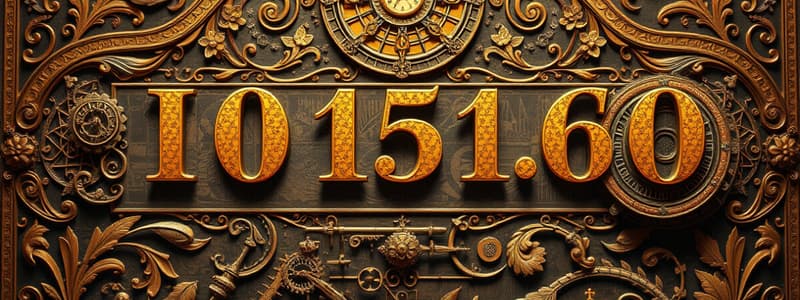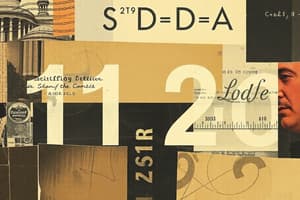Podcast
Questions and Answers
How is the quantity 0.00022 expressed in scientific notation?
How is the quantity 0.00022 expressed in scientific notation?
- 0.22 * 10^-3
- 2.2 * 10^-4 (correct)
- 22 * 10^-5
- 2.2 * 10^4
What is the multiplier for the prefix 'Mega'?
What is the multiplier for the prefix 'Mega'?
- 1,000,000,000
- 1,000
- 1,000,000 (correct)
- 1/1,000,000
Which of the following powers of ten indicates moving the decimal point to the right?
Which of the following powers of ten indicates moving the decimal point to the right?
- 10^-3
- 10^-9
- 10^0
- 10^6 (correct)
If a resistance value is 0.01Ω, how would it be expressed using a prefix?
If a resistance value is 0.01Ω, how would it be expressed using a prefix?
Which suffix correctly represents the multiplier of 1/1,000,000,000?
Which suffix correctly represents the multiplier of 1/1,000,000,000?
When converting from 0.15 milliampere (mA) to microamperes (µA), how many places should the decimal point be moved?
When converting from 0.15 milliampere (mA) to microamperes (µA), how many places should the decimal point be moved?
What is the result when converting 4,500 microvolts (uV) to millivolts (mV)?
What is the result when converting 4,500 microvolts (uV) to millivolts (mV)?
Which operation would express the sum of 15 mA and 8,000 mA in milliamperes?
Which operation would express the sum of 15 mA and 8,000 mA in milliamperes?
To convert 0.00022 microfarad (uF) to picofarads (pF), how many places should the decimal point be moved?
To convert 0.00022 microfarad (uF) to picofarads (pF), how many places should the decimal point be moved?
When adding 50 mV and 25,000 uV, how should the result be expressed?
When adding 50 mV and 25,000 uV, how should the result be expressed?
Flashcards are hidden until you start studying
Study Notes
Scientific Notation
- A number is expressed in scientific notation as a product of a number between 1 and 10 and a power of ten.
- Example: 150,000 = 1.5 × 10^5; 0.00022 = 2.2 × 10^-4.
Multiples and Sub-multiples
- Engineers use multiples and sub-multiples to simplify numbers and avoid excessive zeros.
- Common prefixes and their multipliers include:
- Tera (T): 10^12
- Giga (G): 10^9
- Mega (M): 10^6
- Kilo (k): 10^3
- None: 10^0
- Centi (c): 10^-2
- Milli (m): 10^-3
- Micro (µ): 10^-6
- Nano (n): 10^-9
- Pico (p): 10^-12
Powers of Ten
- Powers of ten are expressed as exponents, indicating decimal point movement.
- For a positive exponent, move the decimal point right; for a negative exponent, move it left.
Metric Unit Conversions
- To convert larger units to smaller units, move the decimal point right.
- To convert smaller units to larger units, move the decimal point left.
- The number of decimal places moved corresponds to the difference in the powers of ten.
Examples of Unit Conversion
- Convert between milliampere (mA) and microampere (µA) requires a three-place movement.
- Example: 0.15 mA to µA = 150 µA (move three places right).
- Example: 4,500 µV to mV = 4.5 mV (move three places left).
Electric Current
- Electric current (I) is the rate of charge flow, measured in amperes (A).
- 1 ampere = 1 coulomb/second.
- Current can be direct (DC) or alternating (AC):
- DC: constant flow of current over time.
- AC: current that varies sinusoidally with time.
Relationship Between Charge and Current
- Charge (q) can be calculated using the number of electrons or protons.
- Example: Charge from 4,600 electrons is -7.369 × 10^-16 C.
- Charge transferred over time can be calculated from current and time.
Voltage and Energy
- Voltage represents the potential difference, calculated as energy per charge.
- Example: Moving a charge of 6 C requires a voltage drop of -5V for -30 J of energy.
Power
- Power (P) is the rate of energy expenditure, measured in watts (W).
- Instantaneous power can be calculated as the product of voltage and current.
- Positive power indicates energy delivery; negative power indicates energy absorption.
Elements in Circuits
- Active elements generate energy (e.g., batteries, generators).
- Passive elements do not generate energy (e.g., resistors, capacitors).
- Independent sources provide constant voltage or current; dependent sources are controlled by other circuit elements.
Types of Sources
- Independent Voltage Source: Maintains terminal voltage irrespective of current.
- Independent Current Source: Maintains specified current irrespective of voltage.
- Dependent sources respond to circuit conditions, categorized as voltage-controlled or current-controlled sources.
Studying That Suits You
Use AI to generate personalized quizzes and flashcards to suit your learning preferences.




